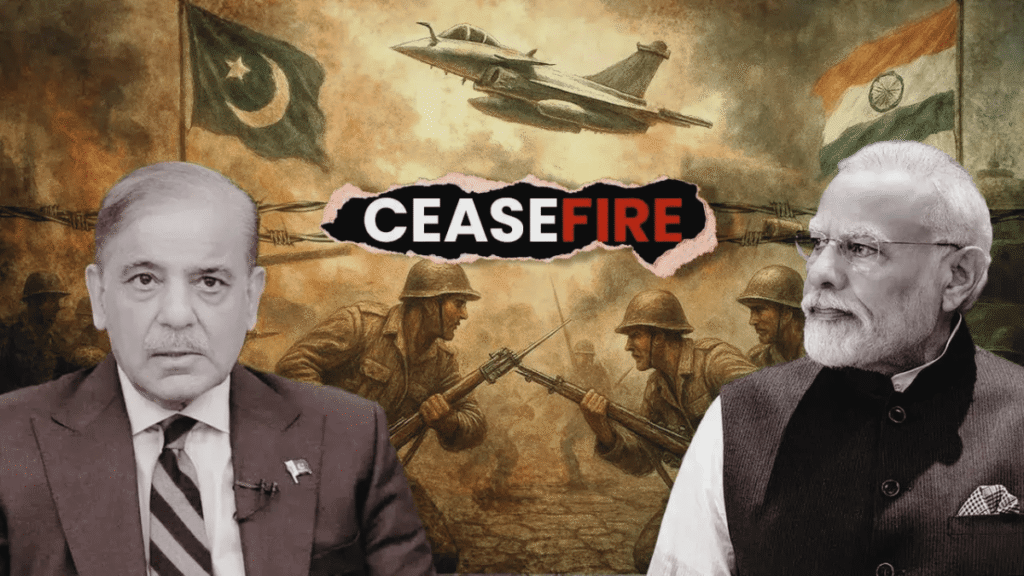A Fragile Peace Shattered by Repeated Violations
On May 10, 2025, a full and immediate ceasefire was announced between India and Pakistan, offering hope for de-escalation after four days of intense military conflict—the worst since the 1999 Kargil War. However, within hours of the truce taking effect at 5:00 PM IST, Pakistan violated the ceasefire, launching attacks that have continued to escalate. As of 11:06 PM IST, Pakistan violated the ceasefire again, with reports of shelling, drone attacks, and explosions across multiple regions, casting serious doubt on the agreement’s viability.
The Ceasefire Agreement: A Brief Moment of Hope
The India-Pakistan ceasefire agreement was brokered after 48 hours of intense diplomacy, with US President Donald Trump announcing the breakthrough on Truth Social: “After a long night of talks mediated by the United States, I am pleased to announce that India and Pakistan have agreed to a FULL AND IMMEDIATE CEASEFIRE. Congratulations to both countries on using Common Sense and Great Intelligence.” The agreement, confirmed by India’s Foreign Secretary Vikram Misri, involved direct talks between the DGMO of India, Lt Gen Rakesh Kapoor, and the DGMO of Pakistan, Lt Gen Ahsan Gulrez. At 3:35 PM IST, the DGMOs agreed to halt all military actions—on land, air, and sea—effective 5:00 PM IST.
Pakistan’s Foreign Minister Ishaq Dar confirmed the truce on X, noting the involvement of 36 countries and praising the US for its role. However, Misri downplayed US involvement, stating the deal was negotiated “directly between the two countries.” The ceasefire between India and Pakistan aimed to end hostilities sparked by a terrorist attack in Pahalgam, Jammu and Kashmir, on April 22, 2025, which killed 26 people and was blamed on Pakistan, leading to India’s Operation Sindoor—a series of strikes on terror sites in Pakistan and Pakistan-Occupied Kashmir.
Pakistan Violates the Ceasefire: Initial Attacks
Just hours after the ceasefire took effect, Pakistan broke the ceasefire, undermining the agreement. By 7:00 PM IST, explosions and shelling were reported in Srinagar, Udhampur, Akhnoor, and along the Line of Control (LoC) in Rajouri, RS Pura, Nowshera, Poonch, Mendhar, Samba, Kathua, and Uri sectors. Indian air defense systems neutralized several Pakistani drones in Jammu, with Jammu and Kashmir CM Omar Abdullah posting on X, “What the hell just happened to the ceasefire? Explosions heard across Srinagar!!!” The Indian Express and India Today reported damage to civilian homes in Srinagar’s Sonawar area, while the Border Security Force (BSF) was authorized to retaliate, engaging Pakistani forces in RS Pura.
Foreign Secretary Vikram Misri, in a 10:00 PM IST briefing, condemned the violations, urging Pakistan to act responsibly. The DGMO of the Indian Army and DGMO of the Pakistan Army are scheduled to speak again on May 12 to address the crisis, but the India-Pakistan ceasefire news paints a grim picture. Air Marshal Diptendu Choudhury (Retd.) told India Today, “I am not surprised at all, we have seen their behaviour over the years,” reflecting widespread skepticism about Pakistan’s intentions.
Latest Violations: Pakistan Strikes Again
As of 11:06 PM IST, Pakistan violated the ceasefire again, intensifying the crisis. Fresh reports from Hindustan Times and The Indian Express confirm drone activity in Punjab (Ferozepur, Gurdaspur, Hoshiarpur), Rajasthan (Barmer, Pokhran), and Gujarat’s Kutch district, alongside continued shelling in Jammu and Kashmir. Blackouts were imposed in border areas, including Barnala, Sangrur, and Vaishno Devi Temple, as a precaution. India TV described the drone incursions as a “cowardly attack,” while LiveMint noted civilian distress in affected regions. The Indian Army and BSF remain on high alert, with the army confirming a pause in shelling along the LoC by 11:00 PM IST, though tensions persist.
The Ministry of External Affairs held a briefing at 11:00 PM IST, addressing the latest violations and debunking misinformation from Pakistan about military successes. External Affairs Minister S Jaishankar reiterated India’s firm stance against terrorism, stating on X that the country’s position remains unchanged despite the ceasefire. Meanwhile, Pakistani PM Shehbaz Sharif’s earlier optimism about a “new beginning” for peace has been overshadowed by the actions of the Pakistani military, raising questions about internal alignment—some speculate that General Asim Munir, Pakistan’s army chief, may not have supported the truce.
Historical Context and Broader Implications
The India-Pakistan conflict over Kashmir has a long history, with the 2003 ceasefire agreement frequently violated by both sides. India officially ended that ceasefire on April 24, 2025, following unprovoked firing by Pakistan in Poonch and Kupwara, as reported on X. The Indus Waters Treaty remains suspended, adding economic pressure to the region. Analyst Brahma Chellaney warned on X that trusting Pakistan is risky, a sentiment echoed by India’s military leadership. The ceasefire agreement between India and Pakistan was a step toward peace, but repeated violations suggest that the India-Pakistan war is far from over.
What’s Next?
With Pakistan breaking the ceasefire repeatedly, the situation remains volatile. The DGMOs’ scheduled talk on May 12 will be critical, but India’s armed forces are prepared for further escalation. For now, civilians in Kashmir and border areas continue to suffer the consequences of this fragile truce. Stay tuned to ScoopUSA24 for the latest India-Pakistan news and updates on this unfolding crisis.
See also https://scoopusa24.com/2025-pahalgam-terror-attack-kashmir-tourists/
